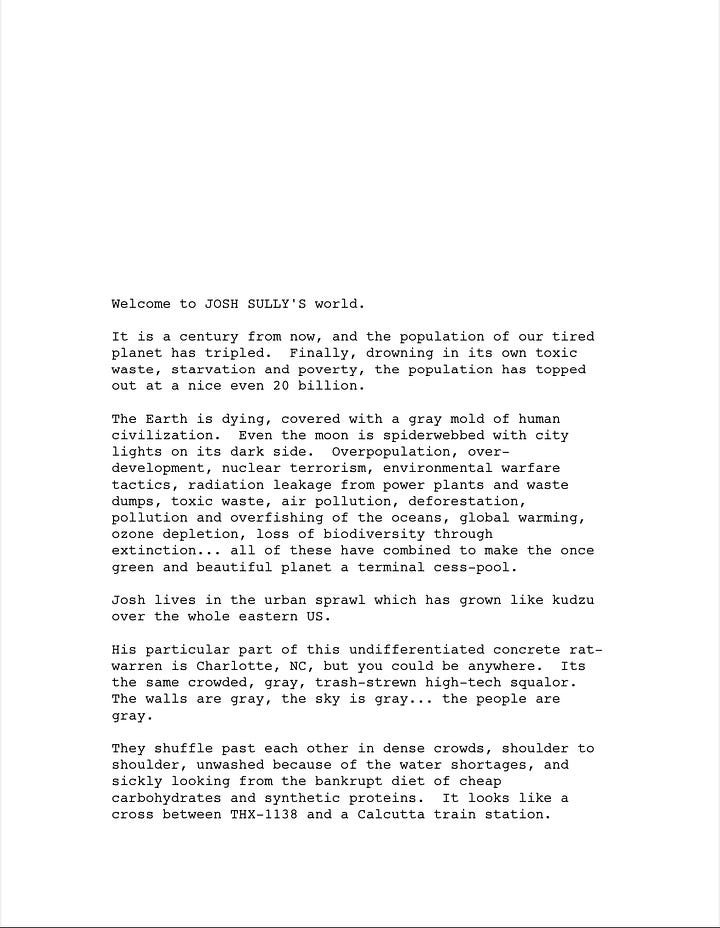How to outline your book without getting bored
How James Cameron made me more productive and changed how I outline novels, screenplays and more
Like many of my neurodivergent writers, I tend to be very good at ideas and even better at getting bored of those very same ideas. It’s often like a light switch. One second the spark of inspiration is there for an idea the next it’s gone. Think of it like a cat with their new favourite toy. My cat will be obsessed with something - sometimes for weeks - but then, seemingly out of nowhere, he couldn’t give a hoot. That’s me but for ideas.
Keeping this in mind, you might think that writing an outline is a perfect recipie for killing my enthusiasm for a project. You might think that spending time creating an outline may trick my brain into thinking the project is done, thus sapping any and all motivation for actually writing the thing. Stephen King talks about this in On Writing. He literally uses the phrase ‘the tiresome tyranny of the outline’ at one point.
He says that he likes to have some sort of an idea when faced with the blank page but that’s it. Writing an outline kills his motivation for writing the thing itself. Given my existing propensity for losing motivation for projects, it would be easy to think this would apply to me. I’ve always thought of myself this way. Until recently, that is.
Pantsers, plotters, gardeners and archetects
George R.R. Martin describes two types of writers; gardeners and archetects. “Achetects plan everything ahead of time, like an achetect building a house,” he says. Conversely, “gardeners dig a hole, drop in a seed and water it.” They tend to it as it grows but they never know how many branches it will have. You’ve probably heard this or something like it before. You’re likely already confident you know which camp you’re a card carrying member of. Martin, for instance, is in the gardener group alongside King.
As I mentioned, I always thought of myself as a gardner but that changed recently when I tried writing a different kind of outline, changing my process completely.
The issue I’d always had with outlining was the issue faced by most gardeners. I’d get to the end and feel like I’d already written the story. As Brandon Sanderson (a noted archetect) said, “outliners have the danger of never actually getting to the prose part of their writing.” That was me. I sat on a mountain of finished and half-formed outlines that gave me that small kick of satisfaction that comes with finishing something but never actually finished writing the prose that comes after. Enter, the ‘scriptment’.
WTF is a ‘scriptment’?
As far as I can tell, the term ‘scriptment’ was traces back to James Cameron, used describe his initial outline for his unamde Spider-man movie. He went on to write a ‘scriptment’ for several of his projects including Avatar. Put simply, the ‘scriptment’ combines elements of a treatment, manuscript and outline.
It often includes prose elements, does away with the traditional formatting of a screenplay or outline and includes dialogue. The Avatar scriptment, for example, lasts about 114 pages and reads like a (long) short story with screenplay elements.
Previously, when outlining I’d relied on a beat-sheet. I even wrote about it a few years ago. These beat-sheets were, I thought, my half-way house between totally pantsing (which would often lead to me getting lost and subsiqently bored) and fully outlining. And they worked, sometimes. Most of the time, though, these beat-sheets would sit on my computer finished and unwritten.


The ‘scriptment’ changed this for me for one simple reason. It feels like, and in many ways is, a first draft. The problem I had with a beat-sheet is that while finishing one can give you that hit of having completed something, they’re never designed to be read by anyone. They are just blueprints. Showing someone a beat-sheet would be like telling someone to move into to the blueprints for their house. The same can’t be said for the ‘scriptment’.
You’re very much writing it to be read, like a treatment, but you’re also including things you might only put into a first draft - dialogue, scene headers etc. This makes it feel like a complete thing when its done but doesn’t sap away all my creative energy for the project in its wake because it also feels like I’m giving myself a leg up on the first draft.
I recently finished writing a ‘scriptment’ for a movie I’ve been sitting on for a while. The ‘scriptment’ allowed me to get the story straight, working out the kinks and developing the setting, character and plot the way an outline might, while also giving me large chunks of a first draft I could copy across to a new document.
You can see how this would work for someone like me. A ‘scriptment’ occupying that space between outline and first draft makes it the perfect method for someone who also occupies the space between gardener and archetect. This method allows me to outline (something I know helps me to finish things) without getting bored of the story I’m writing (a common theme with my process).
Like most writing advice, this process might not work for you. It might be specific to me (and James Cameron) but the core essence of why it works and the thinking that’s gone into refining my process so I actually finish things is worth considering. A ‘scriptment’, like any outline, can really be anything you want it to be. The main thing is that you find the tools that get you writing consistently.
So go try writing a ‘scriptment’. Or maybe a beat-sheet. Or maybe, if you’ve spent the past eight years writing an outline, you should just try writing something. Gardeners, have a crack at drawing up some blueprints and, archetects, have a go at planting a mystery seed and seeing what happens.



